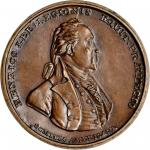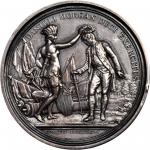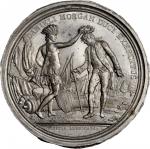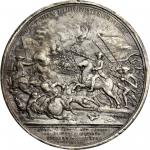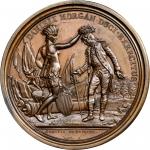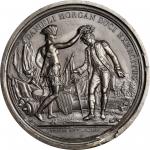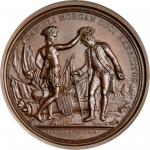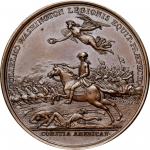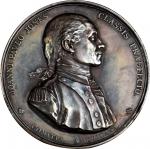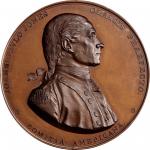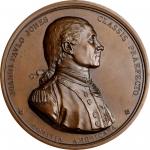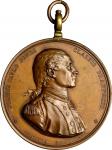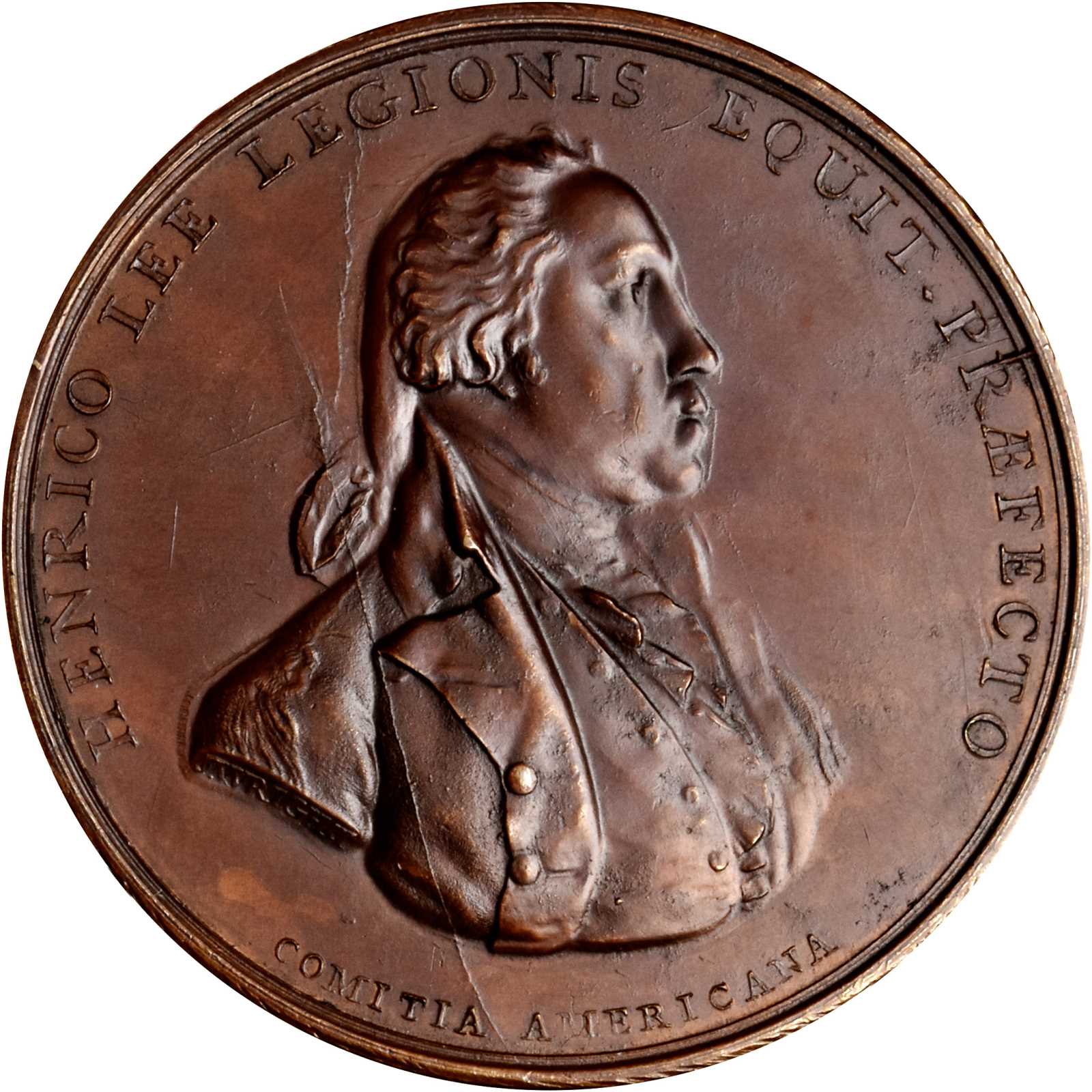1779 (after 1874) Henry Lee at Paulus Hook medal. Betts-575, Julian MI-5. Copper. Original obverse, U.S. Mint copy reverse. Philadelphia Mint. 45.3 mm, 676.8 grains. 3.5 - 3.6 mm thick. Mint State.Plain square edge. Rich mahogany bronzed surfaces are typical of U.S. Mint productions in copper of this era. Nicely struck and well preserved, showing not just the fine details of Wrights obverse, but each of the relics of the dies survival and recovery: scattered rust, the substantial break, the raised file marks, and the ground repairs to the buckling behind the head. The obverse rim shows some filing, accomplished at the Mint to reduce a fin or wire rim. Choice and problem free, a nicer than usual specimen of this scarce restrike. Through 1904, just 66 bronze Lee medals were struck, including those with the blank reverse die (as offered in the previous lot) and those struck with a new copy obverse die produced upon the failure of Wrights original obverse. The usual mintage given for this die marriage is a mere 35 pieces, which fits with its rarity in the market today.<p><strong>The Battle of Paulus Hook</strong><p><strong>The Action: </strong><p>The question "what does Robert E. Lees father have to do with Jersey City, New Jersey?" may be answered succinctly: the Battle of Paulus Hook, a small action of the Revolutionary War that took place on August 19, 1779.<p>Henry Lee III was a Virginia aristocrat, a wealthy planter whose horseback swashbuckling in command of his cavalry unit earned him the nickname Light-Horse Harry Lee. His cousin was Richard Henry Lee, the statesman who initially proposed a motion for independence in the Continental Congress. His son was Robert E. Lee. Light-Horse Harry himself would later serve Virginia as governor (1791-1794) and member of the U.S. House of Representatives.<p>When the Revolution began, Lee was commanding a troop of Virginia dragoons. Serving in the Philadelphia campaign in 1777, their quickness and horsemanship became famous. In the spring of 1778, Lee was promoted to major and given his own unique fighting force: Lees Legion, a mobile body of cavalry and infantry that worked independently as security, reconnaissance, and skirmishers where speed and spontaneity were ultimate advantages. Lee flourished in the command, and while his raids and actions in the Southern Campaigns gave him a lasting military legacy, his Congressional medal came from an attack on a British position in the shadow of occupied New York City.<p>Little was happening militarily in the Northern Theatre by the summer of 1779. The small battle at Stony Point that June was taken as a great victory in the absence of something more significant. The naval expedition against Penobscot, Maine in July was an abject disaster. Washington was encamped at West Point, watching the British in New York from the north. Smaller bodies of troops watched their positions from New Jersey, to the south and west. Perhaps out of boredom, or perhaps borne of a hope that incursions against local militia and patriots would cease, Light-Horse Harry Lee decided to put his independent body of roughly 300 men to use with a nighttime raid against one of British New Yorks perimeter defenses: a fort on the peninsula overlooking New York Harbor called Paulus Hook in modern day downtown Jersey City.<p>The 14-mile march south from New Bridge, along the banks of the Hackensack River, included crossing the swampy Meadowlands near modern-day Secaucus. It was 3 AM by the time Lees dismounted troops arrived at the landmark Priors Mill, today in the middle of a neighborhood in Jersey City. In the next half hour, they moved about a mile toward the fort, forded a flooded canal, overcame the earthwork, and took the fort. There was little opposition in the predawn hours of August 19. The exhausted American forces took 159 prisoners, losing just two dead and three injured, but could not afford to hold the fort with the British Navy able to float in, cannons ready, from the harbor as soon as the sun came up. A hasty retreat was made, returning to their base that afternoon.<p>The British retook Paulus Hook the day after, leading to accusations that Lee had prepared improperly for his sneak attack. He faced a court martial on September 2, 1779 on eight charges, was acquitted on all eight, and congratulated for his conduct. His good name was cleared within a weeks time.<p>Lees daring exploits were well-received at Congress in Philadelphia, a room full of his friends and fellow equestrian-loving aristocrats, even though the battle was ultimately all but meaningless. It took just a few weeks for Lee to receive one of the greatest honors of the entire war: the sole gold medal awarded by Congress to someone below a Generals rank.<p><strong>The Resolution:</strong><p><em>Resolved, That the thanks of Congress be given to his Excellency General Washington, for ordering, with so much wisdom, the late attack on the enemys fort and works at Powles Hook.</em><p><em>Resolved, That the thanks of Congress be given to Major General Lord Stirling, for the judicious measures taken by him to forward the enterprize and to secure the retreat of the party.</em><p><em>Resolved, That the thanks of Congress be given to Major Lee, for the remarkable prudence, address and bravery displayed by him on the occasion; and that they approve the humanity shewn in circumstances prompting to severity, as honourable to the arms of the United States, and correspondent to the noble principles on which they were assumed.</em><p><em>Resolved, That Congress entertain a high sense of the discipline, fortitude and spirit manifested by the officers and soldiers under the command of Major Lee, in the march, action and retreat; and while with singular satisfaction they acknowledge the merit of these gallant men, they feel an additional pleasure by considering them as part of an army, in which very many brave officers and soldiers have proved, by their cheerful performance of every duty under every difficulty, that they ardently wish to give the truly glorious examples they now receive.</em><p><em>Resolved, That Congress justly esteem the military caution so happily combined with daring activity by Lieutenants MCallister and Rudolph, in leading on the forlorn hope.</em><p><em>Resolved, That a brevet and the pay and subsistance of captain be given to Lieutenant McCallister and to Lieutenant Rudolph.</em><p><em>Resolved, That the sum of $15,000 for every prisoner be put into the hands of Major Lee, to be by him distributed among the Sergeants, Drums Rank File non-commissioned officers and soldiers &c. of his Detachment, in such manner as the Commander in Chief shall direct.</em><p><em>Resolved, That a medal of gold, emblematical of this affair, be struck, under the direction of the Board of Treasury, and presented to Major Lee.</em><p><em>- Continental Congress Resolution of September 24, 1779</em><p><p><p><strong>Henry Lee at Paulus Hook</strong><p><strong>The Acquisition:</strong><p>The Henry Lee medal is the only Comitia Americana medal to have not been executed in Paris, an anomalous oversight out of character with the high regard in which Lee was held. Benjamin Franklin was first tasked with obtaining six medals authorized by Congress by the beginning of 1780: Washington, Gates, Wayne, De Fleury, Stewart, and Lee. He started work on De Fleurys medal first, saw it to completion, and never attempted another. When he handed the project off to David Humphreys upon the latters arrival in Paris, Humphreys was never assigned the Lee medal; it had simply been omitted from the list that Robert Morris gave Humphreys in June 1784. Humphreys moved the football a bit, seeing the Gates and Greene medals through to their final production, but left the rest for Jefferson.<p>Despite Jeffersons many connections to Lee - both would serve their native state of Virginia as governor - he never once mentioned Lees medal while in Paris.<p>Jefferson wrote a post-mortem on the medal project, called "Jeffersons Notes on the History of the Medals" by the editors of his papers. It was written in early 1794 after he left the office of Secretary of State, and included the only words he ever drafted about the resolution of the Lee medal issue.<p><em>After I returned to America, Genl. Lee applied to me for the medal voted him by Congress, which Mr. Morriss list had by mistake omitted, and producing to me the resolution of Congress for the purpose I put it in hand with Wright to be executed in Philadelphia. Wright, as well as I recollect, would not agree to warrant against the quality of the steel. His dies broke after they were executed, so that this matter was not concluded when I left Philada.</em><p>he editor of the Jefferson Papers, Professor Julian Boyd, suggested this undated memo could have been written ca. July 1792, when Jefferson turned in his accounting, or "possibly after 31 Dec. 1793 when he left office." The latter is clearly the case. When Jefferson wrote his "Memorandum on State Department Business" on December 31, 1793, a guide to settling his accounts and handing over documents before leaving Philadelphia for the last time as a member of Washingtons cabinet, he references the above-cited medal memorandum in the last line: "Medals voted by Congress-of which Govr. Lees is one. I will prepare and send a special statement of this business, which will require time. I have among my Paris papers some relative to this Subject, which shall be sent with the Statement." The "special statement of this business" is the memo later entitled "Jeffersons Notes on the History of the Medals." <p>The 1794 date of this memo explains why Jefferson speaks with such finality regarding the Lee medal: the engraver was already dead. Joseph Wright, born in Bordentown, New Jersey and hired to be the first engraver of the United States Mint, was struck dead by Philadelphias Yellow Fever plague of 1793. On September 11, 1793, Wrights friend Mordecai Wetherill was dispatched from Wrights home with a notification that he was settling his accounts.<p><em>Joseph Wright being very ill and not expecting to recover, requested the subscriber to make a memorandum as follows: that the said Joseph Wright had presented an account against the United States for cutting a medal, amount fifty guineas. Two essays of a quarter dollars, cut by direction of David Rittenhouse, Esqr., and presented to him (broke in hardening) value about 40 guineas.</em><p>The parenthetical (broke in hardening) appears to have been misplaced, as it was Wrights dies for the Lee medal that had broken in hardening. Jefferson made mention of this a few months later in his December 31, 1793, after action memo as he left the State Department, listing among unfinished business "Wrights representatives to be paid for engraving the Medal of Govr. Lee and (that being broke in hardening) another to be engraved."<p>On January 13, 1795, the United States Treasury issued a warrant to Wrights estate for $233.33, the equivalent to the 50 guineas he billed, for "modeling the likeness and cutting two dies for a medal of Henry Lee Esq." <p>This leads to the ultimate question regarding the Lee medal: was a gold medal ever produced? A single trial is known from the unbroken obverse and the original reverse; it is in the present sale. The American Philosophical Society holds an obverse cliche made from the unbroken state of the die, and the Massachusetts Historical Society holds cliches of both original dies. Correspondence from employees of the Philadelphia Mint in the 1830s and 1840s suggests that no medal for Lee was ever struck there. Julian cites three letters from the Mint Director that said the medal had not been struck and one that said it, in Julians verbiage, "had been struck from cracked dies, " though the exact content of that letter is not more fully mentioned.<p><strong>The Presentation:</strong><p>Your catalogers best assessment of the available evidence - and there is quite a bit - is that Lee never received his gold medal, struck from these dies or any other dies. An engraved "medal" at Princeton that purports to be related to Henry Lee is a late 19th century fantasy.<p><strong>The Henry Lee at Paulus Hook Medal:</strong><p><strong>Obverse:</strong> A portrait of Lee to right in military dress, with a peripheral inscription reading HENRICO LEE LEGIONIS EQUIT. PRAEFECTO or "Henry Lee, officer of the mounted legion." COMITIA AMERICANA appears below. JWRIGHT is signed neatly under the truncation.<p><strong>Reverse: </strong>Two branches of laurel form a peripheral wreath, tied with ribbon and bow at the bottom, with an eight line inscription reading NON OBSTANTIB / FLUMINIBUS VALLIS / ASTUTIA & VIRTUTE BELLICA / PARVA MANU HOSTES VINCIT VICTOSQ. / ARMIS HUMANITATE / DEVINXIT / IN MEMPUGN AD PAULUS HOOK / DIE XIX / AUG. MDCCLXXIX. Loubats translation offers: "Notwithstanding rivers and ramparts, he conquered, with a handful of men, the enemy by skill and valor, and attached by his humanity those vanquished by his arms. In commemoration of the battle of Paulus Hook, August 19, 1779."<p><p>From the John W. Adams Collection. Acquired from Dr. Paul Patterson.



